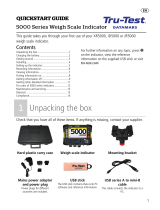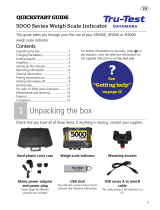
HD Series Load Bars Quickstart Guide
1
QUICKS
T
AR
T GUIDE
HD
Ser
ies Loa
d
Ba
r
s
H
D
800, HD850,
HD10
1
0
This guide takes you through the installation and use of your HD series load bars. The HD series load bars have been
specially designed for heavy duty use and permanent installation under cattle crates, crushes or squeeze chutes.
1
Unpacking the box
For most applications you will need two HD series load bars.
Note:
You may also need adaptor plates for your chute.
2
Weighing system
The Tru Test weighing system consists of a weigh scale indicator and two load bars. The load bars are fitted beneath a
platform or crate and transmit the weight signal to the indicator. The indicator displays and records the weight.

HD Series Load Bars Quickstart Guide
2
3
Getting around
Note:
The load bar foot plates have been locked in position for transportation and installation, and must be released
before weighing (see
Installing the load bars
).
4
Installing the load bars
Before you begin, ensure that the concrete pad is level.
1. Lift the crate so that the load bars can be positioned underneath. Align the holes of the crate and load bar mounting
plates and fix with 12 mm bolts at each load bar end.
Caution!
Dropping the crate with load bars fitted, or dropping the crate onto the load bars can damage the load bars.
2. Lower the crate/load bar assembly onto the concrete slab, ensuring that the load bar foot plates are not twisted or
binding in any way.
3. Fix each foot plate to the slab with a minimum of two 12 mm (½”) masonry anchors (e.g. Dynabolt™).
Install the masonry anchors one at a time, using the clamping action of each anchor to restrain the foot plate for
subsequent drilling. Take care to ensure that the anchors do not force the foot plates sideways and cause
misalignment of the ball and cup loading system.

HD Series Load Bars Quickstart Guide
3
4. Once fixed to the slab, you must ‘unlock’ the bars from the foot plates. To do this:
a) Loosen the locknut that locks the load bar stop bolt to the foot plate. Unscrew the bolt, plastic sleeve and washer
from the foot plate and lift them out completely.
b) Remove the plastic sleeve fitted over each load bar stop bolt.
NEVER remove the rubber tube in the centre of the load bar. This contains the load centring cup assembly.
c) Reassemble the load bar stop bolt, washer, and locknut in the reverse order to the above disassembly.
d) Tighten the load bar stop bolt until there is a clearance of 1.0 to 2.0 mm (0.040 to 0.080”) between the underside
of the head of the load bar stop bolt and the washer. Tighten the locknut down to the foot plate to lock in place.
5. Unlock the other feet of the load bar system as described above.
Make sure that you have removed all eight plastic sleeves.

HD Series Load Bars Quickstart Guide
4
5
Testing
Once installed, you should test with a weigh scale indicator.
1. Connect the load bar cables to a Tru-Test indicator.
2. Turn on and zero the indicator.
3. Put a test weight (which may be yourself or another person) at one end of the platform/crate and note the stable
reading on the indicator.
4. Put the test weight at the other end of the platform/crate and note the stable reading on the indicator.
5. Remove the test weight and note whether the reading returns to zero.
6. If the two readings differ by more than 1 kg OR the reading does not return to zero, see the
Troubleshooting
section.
Periodically repeat the above tests during use and also before first use if the equipment has not been used for some time.
6
Troubleshooting
Fault
Remedy
Reading does not return to
zero between animals
OR
Difference in readings at each
end of the platform
OR
Under reading (readings
lighter than expected).
•
Ensure that the platform/crate is not touching objects that may alter the weights.
Typical causes are binding against fixed metalwork or build up of dirt.
• Check that the load bar feet are sitting evenly on the ground.
• Check that bolt holes are not misaligned, as this may put a residual load on the load
bars.
Reading is unstable.
•
Moisture in the load bar connectors. Remove moisture from the plugs and caps using
methylated spirits, ethyl alcohol, or a suitable electrical contact cleaner. Do not use
stronger spirits, as they may react with the plastic.
• Damaged cable. Return the load cell for servicing.
• Moisture in load cells. Return the load cell for servicing.
Reading moves, display shows
under load or overload.
Damaged cable. Return for service.
7
Further information
Caring for the load bars
• Ensure that the underside of the platform or crate and gap between the load bar housing and foot is kept free of dirt
and stones.
• Do not leave the indicator, load bars or plugs immersed in water.
• Cables should be placed so that they will not be damaged. We recommend routing the cables through plastic pipe or
other conduit to help prevent damage.
• When not in use, always replace the dust caps on the load bar plugs. When the load bars are connected to the
indicator, screw the two dust caps together.
• Remove dust and moisture from the plugs and caps using methylated spirits, ethyl alcohol, or a suitable electrical
contact cleaner. Stronger spirits must not be used, as they may react with the plastic.
Service and warranty information
For service and warranty information, see www.tru-test.com.
Page is loading ...
Page is loading ...
Page is loading ...
Page is loading ...
Page is loading ...
Page is loading ...
Page is loading ...
Page is loading ...
Page is loading ...
Page is loading ...
Page is loading ...
Page is loading ...
Page is loading ...
Page is loading ...
Page is loading ...
Page is loading ...
Page is loading ...
Page is loading ...
Page is loading ...

Wiegebalken der HD-Serie Schnellstartanleitung
24
7
Weitere Informationen
Pfleglicher Umgang mit den Wiegebalken
• Sorgen Sie dafür, dass die Unterseite der Plattform bzw. des Wiegekäfigs frei von Schmutz und Steinen ist.
• Das Terminal, die Wiegebalken und die Anschlüsse dürfen nicht in Wasser oder andere Flüssigkeiten getaucht werden.
• Die Kabel müssen so verlegt werden, dass sie nicht beschädigt werden können. Wir empfehlen, für das Verlegen der
Kabel einen Kabelkanal aus Plastik oder ein Elektroinstallationsrohr zu verwenden, um sie vor Beschädigung zu
schützen.
• Bringen Sie stets die Staubschutzkappen an die Wiegebalkenanschlüsse an, wenn diese nicht in Verwendung sind.
Wenn die Wiegebalken an das Terminal angeschlossen sind, schrauben Sie die beiden Staubschutzkappen zusammen.
• Feuchtigkeit in den Anschlüssen oder Schutzkappen kann mithilfe von Methyl- bzw. Ethylalkohol oder einem
geeigneten Kontaktreiniger entfernt werden. Stärkere Mittel sind nicht geeignet, da diese mit dem Kunststoff
reagieren könnten.
Wartungs- und Gewährleistungsinformationen
Wartungs- und Gewährleistungsinformationen finden Sie unter www.tru-test.com.
© 2016 Tru-Test Limited.
All product names and brand names in this document are trademarks or registered trademarks of their respective holders.
No part of this publication may be photocopied, reproduced, stored in a retrieval system, or transmitted in any form or by any means, electronic,
mechanical, photocopying, recording or otherwise without the prior written permission of Tru-Test Limited. Product specifications may change without
prior notice.
For more information on other quality Tru-Test Group brands and products, visit www.tru-test.com.
Tru-Test Limited
25 Carbine Road
Mt Wellington
Auckland 1060
New Zealand
Postal address:
P O Box 51078
Pakuranga
Manukau 2140
New Zealand
810758 Issue 2, 3/2016
-
 1
1
-
 2
2
-
 3
3
-
 4
4
-
 5
5
-
 6
6
-
 7
7
-
 8
8
-
 9
9
-
 10
10
-
 11
11
-
 12
12
-
 13
13
-
 14
14
-
 15
15
-
 16
16
-
 17
17
-
 18
18
-
 19
19
-
 20
20
-
 21
21
-
 22
22
-
 23
23
-
 24
24
Tru-Test HD Series Quick start guide
- Type
- Quick start guide
- This manual is also suitable for
Ask a question and I''ll find the answer in the document
Finding information in a document is now easier with AI
in other languages
- français: Tru-Test HD Series Guide de démarrage rapide
- español: Tru-Test HD Series Guía de inicio rápido
- Deutsch: Tru-Test HD Series Schnellstartanleitung
- português: Tru-Test HD Series Guia rápido
Related papers
-
 Tru-Test MP Load Bars Quick start guide
Tru-Test MP Load Bars Quick start guide
-
 Tru-Test S1 Weigh System Quick start guide
Tru-Test S1 Weigh System Quick start guide
-
 Tru-Test S1 Weigh System Quick start guide
Tru-Test S1 Weigh System Quick start guide
-
 Tru-Test EziWeigh5 Quick start guide
Tru-Test EziWeigh5 Quick start guide
-
 Tru-Test HD5T Load Bars Quick start guide
Tru-Test HD5T Load Bars Quick start guide
-
Tru-Test S3 Indicator Quick start guide
-
Tru-Test EziWeigh5i Quick start guide
-
 Tru-Test EziWeigh7i Quick start guide
Tru-Test EziWeigh7i Quick start guide
-
 Tru-Test JR5000 ID5000 XR5000 Quick start guide
Tru-Test JR5000 ID5000 XR5000 Quick start guide
-
 Tru-Test JR5000 ID5000 XR5000 Quick start guide
Tru-Test JR5000 ID5000 XR5000 Quick start guide
Other documents
-
Thule Xsporter Pro User manual
-
Volkswagen 5G9 071 151 Installation Instructions Manual
-
Thule Hullavator Pro User manual
-
Thule RAPID TRAVERSE FOOT PACK 480R User manual
-
Volkswagen 1S3 071 126 Installation Instructions Manual
-
Thule Rapid Crossroad Foot Pack User manual
-
CHAUVET DJ CH-01 Reference guide
-
Thule Circuit User manual
-
Thule ThruRide User manual
-
Thule Rapid Gutter Foot Pack User manual































